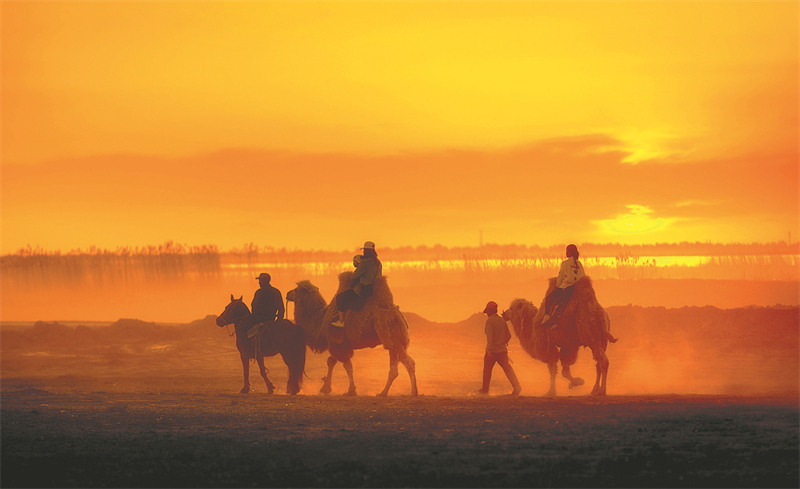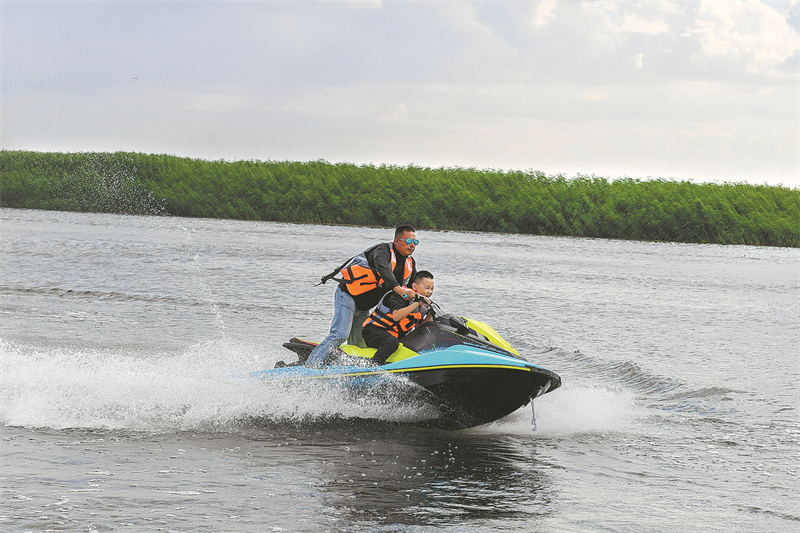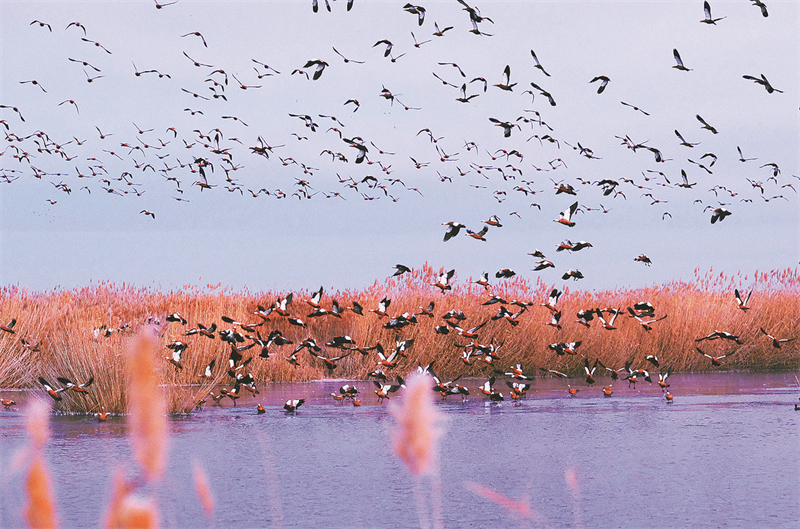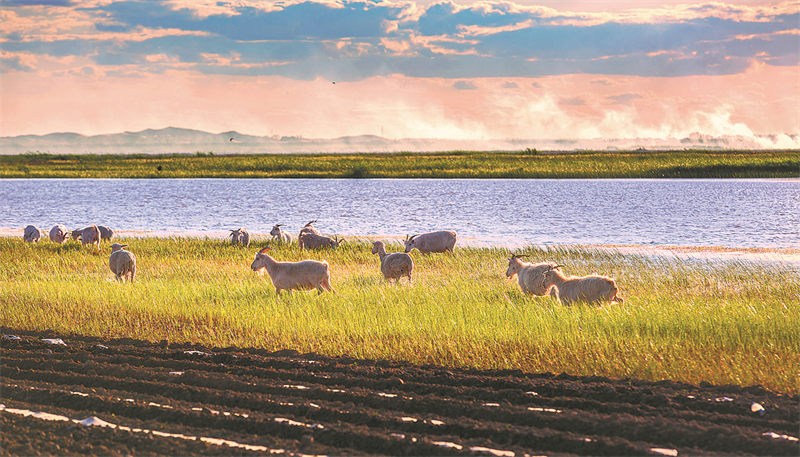Wildlife returns to famous lake in wake of cleanup

Visitors ride camels to enjoy the view of Ulansuhai Nur, known as the "Pearl beyond the Great Wall". CHINA DAILY
Ulansuhai Nur's environment is improving every year, thanks to government initiatives. Yuan Hui reports from Hohhot with Hou Liqiang in Beijing.
Editor's Note: As protection of the planet's flora, fauna and resources becomes increasingly important, China Daily is publishing a series of stories to illustrate the country's commitment to safeguarding the natural world.
In the 1950s, Liu Wenbin's father relocated more than 800 kilometers from his famine-plagued hometown in Hebei province. He settled near Ulansuhai Nur, a famous lake in the Inner Mongolia autonomous region, attracted by the area's reputation as a land of fish and rice.
For years, the fishing industry was a reliable source of income for Liu's family. "When I was a child, we always came back from fishing with the boat full of our catch, accompanied by flocks of birds," the 53-year-old recalled.
However, as urbanization and industrialization accelerated around the lake in the 1990s, Liu witnessed the body of water, widely known as the "Pearl beyond the Great Wall", turn into a black and odorous mass that local people avoided as much as possible.
Now, with a treatment campaign that adheres to the philosophy of "mountains, rivers, forests, farmland, lakes, grassland and deserts are a life community", the local government has made marked progress in just a few years, rejuvenating the lake as a paradise for birds and raising Liu's hopes of seeing the return of the Ulansuhai Nur of his childhood.
Located in Bayannuur in the west of the region, Ulansuhai Nur is home to the largest wetland in the Yellow River Basin and a rare large grassland lake in the desert and semidesert area. As such, it is a natural environmental shield that reins in the sources of sandstorms that affect North China, where Beijing is located.
It is also an important node on the world's eight major bird migration routes, and is one of the world's few avian transit and breeding grounds in the desert and semidesert areas.
Childhood idyll
When Liu, now an official with the Ulansuhai Nur administration, recalled his childhood, he described the lake as a consistent source of joy for him and his peers.
"After school, I seldom stayed home. I frequently went to swim in the lake. When I was thirsty, I drank the lake water directly," he said.
However, he saw the "fabulous environment" of the water begin to deteriorate in the 1990s, which he described as the time when industrialization and urbanization gained momentum.
In addition to runoff water from farmland in the Hetao irrigation area — which covers more than 730,000 hectares of arable land and is known as "the granary outside the Great Wall" — wastewater from the expanding urban areas and the booming industrial sector kept pouring into the low-lying lake.
The worst situation Liu can recall in Ulansuhai Nur came in 2008, when the lake was hit by an outbreak of algae which depleted the oxygen levels in the water. "The entire surface of the lake was blanketed by yellow algae. From a distance, it looked like a desert," he said.
It was at this time that Liu started working for a local tourism company. At the lake, he witnessed the deaths of large numbers of fish and noticed that the birds had started leaving.
"Nobody would swim in the lake anymore. When our excursion vessel moved, its screws churned up black water and a foul odor," he said. His company received so few tourists that he was on the brink of unemployment, he said.

Watersports provide fun on the lake. WANG XIAOBO/FOR CHINA DAILY
In response, the central authorities paid great attention to the worsening environmental situation at Ulansuhai Nur.
In March 2019, when President Xi Jinping attended a discussion panel with his fellow deputies from Inner Mongolia at the second session of the 13th National People's Congress, the top national legislature, he urged greater efforts for environmental improvements in Ulansuhai Nur, as well as the Hulun and Daihai lakes, which are also located in the region.
Xi urged Inner Mongolia to prioritize environmental protection and green development as the region explored new ways of achieving high-quality development.
While deliberating with fellow deputies from the region at the fourth session of the 13th NPC in March 2021, Xi said he had issued directives about the lake many times. There had been a marked improvement in the area, but persistent efforts were still needed, he said.
Xi visited Ulansuhai Nur in June. During his visit, he called for concerted efforts to treat and protect the lake by pursuing a clear path to provide future generations with a beautiful homeland of lush mountains, lucid waters and clean air.

Migratory birds fly above Ulansuhai Nur in Bayannuur, Inner Mongolia autonomous region, which is an important stop for avian visitors. LI KE/FOR CHINA DAILY
Pilot program
In 2019, the Ulansuhai Nur Basin was chosen by the ministries of finance, natural resources, and ecology and environment to pilot a holistic conservation program and systematic governance of all types of terrain.
"Mountains, rivers, forests, farmland, lakes, grassland and deserts are a life community" is one of the 10 tenets of Xi Jinping Thought on Ecological Civilization, whose core principle is the harmonious coexistence of humankind and nature.
According to a report by Xinhua News Agency the same year, the total planned investment for the pilot project totals 5.6 billion yuan ($768 million).
Key programs include the control of desertification, remediation of former mining areas, conservation of soil and water, protection of biodiversity and control of agricultural pollution, and the restoration of connectivity between different bodies of water.
For example, in the Hetao irrigation area, local authorities have rolled out a campaign that is designed to control the use of chemical fertilizers, pesticides, water and mulching film, according to the Bayannuur government.
The city has overseen a decline in the use of chemical fertilizers and pesticides since 2018, it said, adding that a series of measures have been rolled out to prevent wastewater from entering the lake.
In addition to strengthening its sewage-disposal capabilities, Bayannuur has made all-out efforts to fully tap the potential of reclaimed water to help meet demand for industrial use and landscaping, it said. Unused reclaimed water is now diverted into constructed wetlands for purification before being discharged into Ulansuhai Nur, it added.
To further promote improvements in water quality and environmental remediation in the lake, local authorities have diverted an average of approximately 600 million cubic meters of water into it every year since 2018.
In the Ulan Buh Desert, the country's eighth-largest arid area, which is located in the upper areas of Ulansuhai Nur, a number of projects have been launched that sustainably integrate desert control, solar energy generation and the development of agriculture.
For example, under the program, herbs are planted beneath solar panels. In Dengkou county, most of which is covered by the desert, the construction of a base that follows the model commenced in April last year.
With 740,000 solar modules, the base is expected to generate 726 million kilowatt-hours of electricity a year and produce herbs worth 30 million yuan, while greening 800 hectares of desert, the Dengkou government said.

Goats wander along the banks of Ulansuhai Nur. CHINA DAILY
Significant changes
As a photographer, Qi Hongyan has paid regular visits to Ulansuhai Nur since the 1980s.
The 66-year-old said he noticed that the local government had rolled out measures to remediate the lake in 2010, but little progress was made in the first few years.
When he passed the lake in 2012, he still saw a lot of dead fish floating on the surface, he recalled.
He said he saw some mild environmental improvements in the lake in the following years, but significant changes only occurred after 2020. Instead of being black, "the lake's water was green and clear" when he visited it more than two years ago.
"Before 2020, it was extremely difficult to see mute swans in the lake. Since then, though, there have been many, and the number of the birds is especially large this year," he said.
During one of his visits to the lake this year, Qi saw an island in the water that was "blanketed by birds", he said.
According to the Bayannuur government, the quality of the lake's water has been upgraded from below Grade V, the worst in the country's five-tier quality system for surface water, to Grade IV.
The number of birds around Ulansuhai Nur has also risen, with 264 species monitored at the lake recently, compared with 185 in 2000, it said. The number of mute swans living around the body of water has also climbed to more than 800 from roughly 200 in 2000.
Zhang Zhijia, a resident of Wayaotan, a village near Ulansuhai Nur, is keenly aware of the environmental improvements at the lake.
The overwhelming number of mosquitoes that made people avoid going outside in the evening as far as possible has fallen significantly as the water quality has improved.
"But the number of fish and shrimps has risen greatly," Zhang said with a smile.
Liu, the official with the Ulansuhai Nur administration, said he has found that swan geese, which disappeared from the lake as its environment deteriorated, are now returning in large numbers, indicating that the environment has greatly improved.
"We may not soon be able to see the water in the lake restored to the state it was in my childhood, when we could swim in the lake and directly use water from it for drinking and cooking, but definitely I think we are heading in that direction," he said.



 Print
Print Mail
Mail


